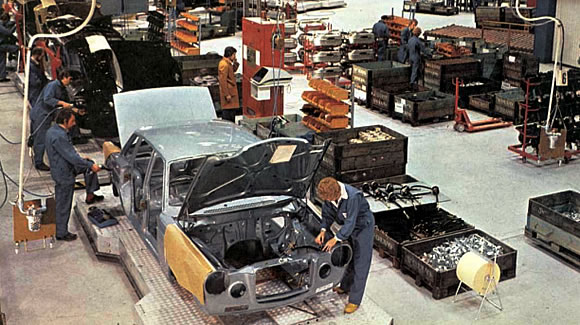
The video below offers a glimpse of the Volvo assembly line in Kalmar, Sweden in the early 1970s as it produces the 200 series model. It’s an educational video demonstrating new factory production techniques pioneered by Volvo and offers an amazing glimpse at how Volvo was trying to humanize the assembly line and improve worker’s satisfaction with their jobs.
IPD posted the video on their site, and I did a little research to find more info on this particular plant and the rational behind Volvo’s new assembly line.
Volvo was attempting to alleviate some of the disconnect workers felt toward the cars they were building. By having a small team of workers work on one car at a time, rather than spreading them out on an assembly line, they hoped to build a more productive and engaged workforce. This was a fairly direct answer to Fordist specialized production and the Marxist theory of worker alienation:
In a nutshell Marx’s Theory of Alienation is the contention that in modern industrial production under capitalist conditions workers will inevitably lose control of their lives by losing control over their work. Workers thus cease to be autonomous beings in any significant sense. Under pre-capitalist conditions a blacksmith, e.g., or a shoemaker would own his own shop, set his own hours, determine his own working conditions, shape his own product, and have some say in how his product is bartered or sold. His relationships with the people with whom he worked and dealt had a more or less personal character.
Under the conditions of modern factory production, by contrast, the average worker is not much more than a replaceable cog in a gigantic and impersonal production apparatus. Where armies of hired operatives perform monotonous and closely supervised tasks, workers have essentially lost control over the process of production, over the products which they produce, and over the relationships they have with each other. As a consequence they have become estranged from their very human nature, which Marx understood to be free and productive activity.
For Volvo, their experiment was expected to produce healthier and more productive workers. According to the Bulletin of Science, Technology and Society:
Operators… have low physical and timing demands, high psychological demands because of increased duties and high-decision latitude due to varied and complex skills utilized, the two latter characterizing active work. Operators at standard assembly lines have higher levels of physical and timing demands, lower levels of psychological demand, and lower control, characterizing high-strain work. Active work is related to lower incidence of heart disease than high-strain work.
Last year I experienced both side of this work paradigm, although it was in the field of web design. I worked as a designer for the websites of two different magazine companies, Hearst and Condé Nast. At Hearst I was part of a small team of designers producing graphics for thirteen different magazines, including Harper’s Bazaar and Cosmopolitan. Work requests came from editors rather anonymously through an internal ticketing system and there was often no interaction with anyone other than the other designers, who all had tasks which were quite different from mine. I found it quite stressful, and never caught the flow. I was fired after 2 months.
At Condé Nast, in contrast, I was part of Portfolio Magazine’s online group. There I collaborated with web producers, marketing directors, traffic statisticians and programmers to bring out new products. We each had different strengths and worked directly together to focus on one on-line property. There was a greater kinship among my co-workers and closer engagement with the product. It also meant that we were better able to enjoy the success or failure of what we produced, since we were much closer to it.
While this utopian idea of collaborative teamwork sounds great in theory, apparently it didn’t do enough good for the bottom line. Many of us at Condé Nast were laid off in restructurings last year, Portfolio magazine was shut down, and management decided to absorb some of the tech workers into specialized teams, similar to Hearst. I was too new to have any staying power and was let go, along with many of my friends and collegues.
Volvo’s worker-democracy experiment didn’t pan out for the long-term either. They shut down their Kulmar and Uddevalla plants in 1992 and the auto division was purchased by Ford in 1999, tragically sucking them into the symbolic originator of alienated production.
I like to think that the quality and longevity of 1980s Volvos has something to do with the new way the company produced cars and the collaboration of some of its workers. The poor quality of American cars cranked out on assembly lines in the same era is a sharp contrast to our trusty bricks.

I finally decided to write a comment on your blog. I just wanted to say good job. I really enjoy reading your posts.
The headlights kinda look like a 164 rather than a 200…
Edit – ah, could just be the static picture above. Neat to see the assembly – I see I install the rear shocks in the same way as they do… ;)
Yeah, I got the picture from somewhere else. The video is definitely 200 series.
It’s to know that in those times Volvos were practically hand assembled. I had the same green 240.
Hi there, after reading this awesome article i am
too delighted to share my know-how here with mates.
Thanks for sharing this video.Its a informative post about Volvo production.I really feel great after reading your post.